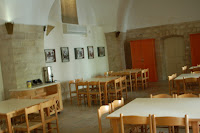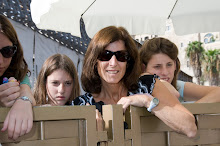Showing posts with label biblical archaeology. Show all posts
Showing posts with label biblical archaeology. Show all posts
Friday, October 31, 2008
New Tunnel Discovered within City of David
In a briefing last night, Eilat Mazar, a renowned archaeologist who has been excavating at the City of David for a number of years, presented findings highlighting the discovery of a "gutter", part of an ancient water system descried in 2 Sam 5:8. For years scholars have believed that it was through this water system that David was able to conquer Jebus, later known as the City of David. The gutter was discovered last winter after a snowfall in the excavation area that pertained to the First Temple period, known as Area G. The passageway is wide enough for pedestrian traffic and travels north/south which is the direction of the Temple Mount and connects with a structure identified as the palace of King David. An article written by Nadav Shragai providing more information on this latest discovery can be found at http://www.haaretz.com/
Labels:
biblical archaeology,
City of David,
Jerusalem
3,000 year old City Discovered in Valley of Elah
Published yesterday in the New York Times is an extremely interesting article depicting recent findings of a possible ancient city located south of Jerusalem in the Valley of Elah. Archaeologists are unearthing antiquities including a formidable fortress, that may possibly support writings within the Scriptures which emphasize the importance of Jerusalem and King David during the period of the 10th century B.Cc. The article can be found at http://www.nytimes.com/2008/10/30/world/middleeast/30david.html?_r=1&ei=5070&emc=eta1&oref=slogin
Labels:
biblical archaeology,
Israel,
Jerusalem,
King David,
Valley of Elah
Friday, October 3, 2008
Likely 1st Century ruins on display underneath Sisters of Nazareth guesthouse
 Sitting quietly off the main shuk road in the heart of Nazareth, less than one block away from the famous Church of the Annunciation (also known as the Church of All Nations), lies the quaint guesthouse owned and managed by the Religious Sisters of Nazareth, a Roman Catholic order of nuns who have had a presence in the Holy land since the late 1800's. The Sisters have owned the magnificent building for over 100 plus years and recently converted parts of their facility into a lovely little guest house. However, the comfortable yet simple accommodations are not all that meets the eye. Hidden several metres below the tiled terraces are significant ruins dating back to the 1st century or possibly earlier, an archaeological find discovered in the early 1900's .
Sitting quietly off the main shuk road in the heart of Nazareth, less than one block away from the famous Church of the Annunciation (also known as the Church of All Nations), lies the quaint guesthouse owned and managed by the Religious Sisters of Nazareth, a Roman Catholic order of nuns who have had a presence in the Holy land since the late 1800's. The Sisters have owned the magnificent building for over 100 plus years and recently converted parts of their facility into a lovely little guest house. However, the comfortable yet simple accommodations are not all that meets the eye. Hidden several metres below the tiled terraces are significant ruins dating back to the 1st century or possibly earlier, an archaeological find discovered in the early 1900's .Sister Stephana of Italy was our tour guide and accompanied us throughout our underground
 exploration. The site consists of a series of caves including at least one large home as well as water cisterns hidden beneath the residence, a familial burial area as well as several other rooms. The large water cistern is known as the Cistern of the Great Church, and is a sizeable well that was apparently used to store water for the family and possibly others that lived above and nearby. The architecture is somewhat suggestive of 1st century, with Herodian stones displayed in several areas. The burial style suggests Jewish roots, which would be likely considering the early dating of this house and its location in Nazareth, originally a Jewish village and believed to be home home of Jesus during his youth. Beyond that, there is evidence of additional development during the Byzantine and possibly the Crusader period as well.
exploration. The site consists of a series of caves including at least one large home as well as water cisterns hidden beneath the residence, a familial burial area as well as several other rooms. The large water cistern is known as the Cistern of the Great Church, and is a sizeable well that was apparently used to store water for the family and possibly others that lived above and nearby. The architecture is somewhat suggestive of 1st century, with Herodian stones displayed in several areas. The burial style suggests Jewish roots, which would be likely considering the early dating of this house and its location in Nazareth, originally a Jewish village and believed to be home home of Jesus during his youth. Beyond that, there is evidence of additional development during the Byzantine and possibly the Crusader period as well.The Sisters of Nazareth provide complimentary group tours of the site with advance notice.



Thursday, September 4, 2008
Quick stop at Kursi
At the base of the Golan, we stopped by Kursi (http://www.parks.org.il/ParksENG), a Jewish fishing village during the mishnaic and talmudic periods, remains of which were accidentally discovered after the Six Day War, when a road was paved along the eastern bank of the Sea of Galilee. Excavations revealed the largest Byzantine-period monastery in Israel. The monastary as well as the church inside were built in the middle of the fifth century C.E. and were later damaged most likely during Persian invasion (614 C.E.). The church was repaired but abandoned in the eighth century and never again used for prayer. A mosaic floor with pictures of animals (chickens, geese, doves, cormorants, and fish), and pictures of plants such as citrons, dates, pomegranates, and grapes were uncovered, some of which was vandalized. According to the New Testament, Jesus healed a man possessed by demons in Kursi.
Kursi is run by the Israel Parks Authority and is open daily.
Kursi is run by the Israel Parks Authority and is open daily.
Labels:
biblical archaeology,
Golan Heights,
Kursi,
miracles
Subscribe to:
Posts (Atom)




